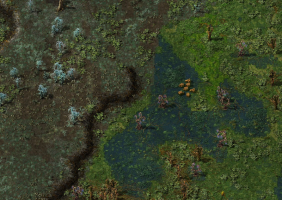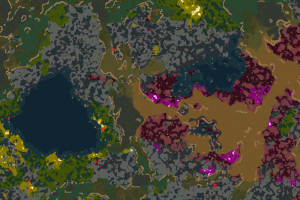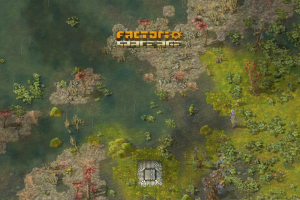Gleba: Difference between revisions
Explain how to obtain basic resources |
Added exclusive resources. No longer a stub. |
||
| (33 intermediate revisions by 10 users not shown) | |||
| Line 1: | Line 1: | ||
{{Languages}} | {{Languages}} | ||
{{About/Space age}} | {{About/Space age}} | ||
[[File:gleba_preview.png|210px|right]]'''Gleba''' is a moist, agricultural planet with fungal hills and swampy lowlands. | [[File:gleba_preview.png|210px|right]]'''Gleba''' is a moist, agricultural [[planet]] with fungal hills and swampy lowlands. | ||
It is home to the [[pentapods]]{{SA}}, which are spider-like [[enemies]] who are attracted to the scent of biological processing, similar to the way that [[Nauvis]] creatures negatively respond to [[pollution]]. One of the most prominent traits of Gleba is that nearly everything takes a biological form. | It is home to the [[pentapods]]{{SA}}, which are spider-like [[enemies]] who are attracted to the scent of biological processing called Spores, similar to the way that [[Nauvis]] creatures negatively respond to [[pollution]]. One of the most prominent traits of Gleba is that nearly everything takes a biological form. | ||
[[Planet discovery Gleba (research)]] is required to travel to the planet. | |||
=== | == Achievements == | ||
{{Achievement|visit-gleba}} | |||
== | == Exclusive Items == | ||
[[Yumako]] and [[jellynut]] fruits can only be obtained on Gleba. Trees bearing these fruits can be harvested by an [[agricultural tower]]; through seeds, a new crop can be planted and harvested indefinitely. | |||
The following items are unlocked on Gleba and can only be crafted on-planet: | |||
* {{imagelink|Agricultural science pack|space-age=yes}} | |||
* {{imagelink|Artificial jellynut soil|space-age=yes}} | |||
* {{imagelink|Artificial yumako soil|space-age=yes}} | |||
* {{imagelink|Overgrowth jellynut soil|space-age=yes}} | |||
* {{imagelink|Overgrowth yumako soil|space-age=yes}} | |||
* {{imagelink|Biochamber|space-age=yes}} | |||
The following items are unlocked on Gleba but can be crafted elsewhere: | |||
* {{imagelink|Agricultural tower|space-age=yes}} (Buildable only on [[Gleba]] and [[Nauvis]]) | |||
* {{imagelink|Captive biter spawner|space-age=yes}} (spawners can be captured with Gleba's [[Capture bot rocket]], constructed with [[Aquilo]] research, and exclusively produced and placed on Nauvis). | |||
* {{imagelink|Heating tower|space-age=yes}} | |||
* {{imagelink|Biolab|space-age=yes}} (unlocked with Gleba science, but exclusively produced and placed on Nauvis) | |||
* {{imagelink|Rocket turret|space-age=yes}} | |||
* {{imagelink|Spidertron}} | |||
* {{imagelink|Stack inserter|space-age=yes}} | |||
* {{imagelink|Toolbelt equipment|space-age=yes}} | |||
* {{imagelink|Productivity module 3}} | |||
* {{imagelink|Efficiency module 3}} | |||
Note that while stack inserters ''can'' be crafted off of Gleba, the use of fast-[[spoilage mechanics|spoiling]] [[jelly]] as an ingredient makes doing so somewhat impractical, though hardly impossible. | |||
==Surface== | ==Surface== | ||
| Line 141: | Line 56: | ||
|} | |} | ||
===Biomes=== | === Biomes === | ||
Gleba's terrain consists of elevated regions of dry, buildable terrain and marshy lower areas marbled with [[shallow water]] that cannot directly be built upon without [[landfill]]. [[Cliff]]s usually represent the transition from lower lying areas to higher ones. The dark highlands biome are where [[stone]] may be found. The orange or turquoise midland biomes are also elevated and lack shallow water. | |||
[[Enemies#Wrigglers|Pentapod]] enemies can only build nests on shallow water tiles (regardless of biome), so midlands and highlands act as natural barriers to their expansion. Artificial barriers can be created by using landfill on available shallow water. | |||
The blue biomes are marshes that are typically found next to deep water lakes. Outside of their particular flora, these lands contain nothing special. | |||
The red and green biomes are marshlands where [[Jellystem]] and [[Yumako tree]]s can be found, respectively. They also contain [[Stromatolite|copper and iron stromatolites]] in abundance, making them good sources of ore and ore bacteria. | |||
For the purposes of where crops can be planted, each of these two biomes has 3 kinds of tiles. | |||
Fertile soil tiles are those surrounding natural [[Jellystem]]s and [[Yumako tree]]s. These tiles can be planted with seeds and grow trees without any additional intervention. However, there are usually not very many such tiles in a biome. | |||
Around fertile soil tiles are a larger number of wetland tiles. These are shallow water tiles that are not initially plantable, but artificial [[Artificial jellynut soil|jellynut]] and [[Artificial yumako soil|yumako]] soil tiles will make them fertile. | |||
The vast majority of the biome consists of darker red or green tiles (some are shallow water marshes, while others are buildable terrain) of types other than the above. All of these tiles can have overgrowth [[Overgrowth jellynut soil|jellynut]] and [[Overgrowth yumako soil|yumako]] soils placed on them, making virtually the entire biome farmable (though at substantial cost). | |||
On the map view, the lightest colored tiles in these biomes are fertile soils, the slightly darker tiles around them are wetlands, and the rest are tiles that can have overgrowth soils placed on them. | |||
Note that the overgrowth soils can be placed on the same wetland tiles that artificial soils can be placed on. Overgrowth soils have no special effects on those tiles, and they are far more expensive than artificial soils. As such, care should be taken to avoid using the more expensive soils where the less expensive ones will do fine. | |||
== Mechanics == | == Mechanics == | ||
{{main|Spoilage mechanics}} | |||
Most biological products on Gleba are "spoilable". A spoilable item has an inherent timer attached to it, which begins at the item's creation. When the timer reaches 0, the item is transformed into [[spoilage]],{{SA}} with a few exceptions. This process is inevitable and cannot be stopped. | Most biological products on Gleba are "spoilable". A spoilable item has an inherent timer attached to it, which begins at the item's creation. When the timer reaches 0, the item is transformed into [[spoilage]],{{SA}} with a few exceptions. This process is inevitable and cannot be stopped. | ||
The exact time differs per item, ranging anywhere from a few minutes to 2 hours. This means that item throughput is more important than ever on Gleba, and buffering a large stockpile is ineffective, as items can spoil within containers. | The exact time differs per item, ranging anywhere from a few minutes to 2 hours. This means that item throughput is more important than ever on Gleba, and buffering a large stockpile is ineffective, as items can spoil within containers. | ||
The [[Biochamber]], Gleba's special production building, uses a fuel source, [[nutrients]]. Nutrients also can spoil, and have a short, 5 minute spoil time. | |||
== Access to basic resources == | |||
* [[Water]] is readily available using offshore pumps | |||
* [[Stone]] can be mined from patches on the surface as normal | |||
* [[Iron ore]] can be obtained from [[iron bacteria]], which can be cultivated in a [[biochamber]] using [[iron bacteria cultivation]] | |||
* [[Copper ore]] can be obtained from [[copper bacteria]], which can be cultivated in a biochamber using [[copper bacteria cultivation]] | |||
* [[Coal]] can be obtained via [[coal synthesis]] | |||
* [[Crude oil]] is not available. However: | |||
** [[Plastic bar]]s can be obtained from [[bioplastic]] | |||
** [[Sulfur]] can be obtained from [[biosulfur]] | |||
** [[Lubricant]] can be obtained from [[biolubricant]] | |||
** [[Rocket fuel]] can be obtained from [[rocket fuel from jelly]] | |||
** [[Heavy oil]] can be obtained using [[coal liquefaction]], if the initial heavy oil is shipped in from another planet. This is only really useful for [[flamethrower turret]]s, since all other oil products can be obtained more efficiently using the bio recipes. [[Simple coal liquefaction]] is also an option if the [[calcite]] is shipped in from [[space platform]]s using [[advanced oxide asteroid crushing]] or from [[Vulcanus]]. | |||
=== Power production === | |||
The | The heating tower is a burner device can be used to generate electricity via the use of [[heat exchanger]]s and steam turbines. Gleba renewably generates all its resources, which includes rocket fuel. Traditional boilers can also be used. | ||
==Space routes== | |||
[[Gleba]] is connected to 4 other planets: [[Nauvis]], [[Vulcanus]]{{SA}}, [[Fulgora]]{{SA}}, and [[Aquilo]]{{SA}}. | |||
{| class="wikitable" | {| class="wikitable" | ||
|+ | |+ Planet Distance | ||
|- | |- | ||
! | ! Planet !! Distance (km) | ||
|- | |- | ||
| | | [[Nauvis]]|| 15,000 | ||
|- | |- | ||
| {{ | | [[Vulcanus]]{{SA}}|| 15,000 | ||
|- | |- | ||
| {{ | | [[Fulgora]]{{SA}}|| 15,000 | ||
|- | |- | ||
| {{ | | [[Aquilo]] {{SA}}|| 30,000 | ||
|} | |||
Asteroid rate graphs: | |||
{| class="wikitable" style="text-align:center;" | |||
|- | |- | ||
| | | [[File:Asteroid_chart_Nauvis_Gleba.png]] <br> Space route from [[Nauvis]] to [[Gleba]] | ||
| [[File:Asteroid_chart_Vulcanus_Gleba.png]] <br> Space route from [[Vulcanus]] to [[Gleba]] | |||
|- | |- | ||
| | | [[File:Asteroid_chart_Gleba_Fulgora.png]] <br> Space route from [[Gleba]] to [[Fulgora]] | ||
| [[File:Asteroid_chart_Gleba_Aquilo.png]] <br> Space route from [[Gleba]] to [[Aquilo]] | |||
|} | |||
Graph legend: | |||
{| class="wikitable" | |||
|- | |- | ||
! Asteroid type | |||
! Chunk | |||
! Medium | |||
! Big | |||
|- | |- | ||
| | | [[File:Metallic asteroid chunk.png|32px]] Metallic | ||
| <span style="color: blue;">●</span> Blue | |||
| <span style="color: red;">●</span> Red | |||
| <span style="color: cyan;">●</span> Cyan | |||
|- | |- | ||
| | | [[File:Carbonic asteroid chunk.png|32px]] Carbonic | ||
| <span style="color: orange;">●</span> Orange | |||
| <span style="color: yellow;">●</span> Yellow | |||
| <span style="color: brown;">●</span> Brown | |||
|- | |- | ||
| | | [[File:Oxide asteroid chunk.png|32px]] Oxide | ||
| <span style="color: green;">●</span> Green | |||
| <span style="color: magenta;">●</span> Magenta | |||
| <span style="color: purple;">●</span> Purple | |||
|} | |||
==Orbit== | |||
===Properties=== | |||
{| class="wikitable" | |||
|- | |- | ||
! Property !! Value | |||
|- | |- | ||
| | | Solar Power || 200% | ||
|- | |- | ||
|} | |} | ||
= | {| class="wikitable" | ||
|+ Asteroid Spawning Types | |||
|- | |||
! [[Asteroids| Asteroid]] Type !! Spawn Ratio | |||
|- | |||
| [[Metallic asteroid chunk]] || 2 | |||
|- | |||
| [[Carbonic asteroid chunk]] || 5 | |||
|- | |||
| [[Oxide asteroid chunk]] || 1 | |||
|- | |||
| [[Promethium asteroid chunk]] || 0 | |||
|} | |||
{| class="wikitable" | |||
|+ Asteroid Spawning Sizes | |||
|- | |||
! [[Asteroids| Asteroid]] Size !! Spawn % | |||
|- | |||
| Chunk|| .30 | |||
|- | |||
| Medium|| .25 | |||
|- | |||
| Big || 0 | |||
|- | |||
| Huge || 0 | |||
|} | |||
'''Note:''' | |||
* | *Chunks spawn at Nauvis at 1.25% | ||
*Huge Asteroids only spawn past [[Aquilo]]{{SA}} | |||
* | |||
== Gallery == | == Gallery == | ||
<gallery widths="300px" heights="200px"> | <gallery widths="300px" heights="200px"> | ||
gleba_landscape.png|Example landscape of Gleba. | gleba_landscape.png|Example landscape of Gleba. | ||
Gleba_map.png|Example mapview of Gleba, different colors represent different biomes. | |||
Gleba landscape titlescreen.png|Gleba seen on the expansion's title screen. | |||
</gallery> | </gallery> | ||
== Trivia == | == Trivia == | ||
* In biology, a gleba is a fleshy, spore-filled inner mass of some | * In biology, a gleba is a fleshy, spore-filled inner mass of some fungus like the puffball. | ||
* During development, Gleba was once named ''Bacchus'', after the Roman god of fertility, orchards, and vegetation. | * During development, Gleba was once named ''Bacchus'', after the Roman god of fertility, orchards, and vegetation. | ||
| Line 238: | Line 214: | ||
* Introduced in [[Space Age]]{{SA}} expansion. | * Introduced in [[Space Age]]{{SA}} expansion. | ||
}} | }} | ||
== See also == | |||
* [[Aquilo]] {{SA}} | |||
* [[Fulgora]] {{SA}} | |||
* [[Nauvis]] | |||
* [[Vulcanus]] {{SA}} | |||
* [[Space platform]] {{SA}} | |||
{{C|Planets}} | {{C|Planets}} | ||
{{SpaceNav}} | {{SpaceNav}} | ||
Latest revision as of 05:08, 20 September 2025
![]() Space Age expansion exclusive feature.
Space Age expansion exclusive feature.
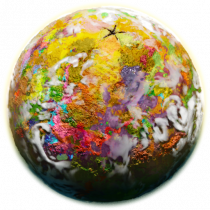
Gleba is a moist, agricultural planet with fungal hills and swampy lowlands.
It is home to the pentapods![]() , which are spider-like enemies who are attracted to the scent of biological processing called Spores, similar to the way that Nauvis creatures negatively respond to pollution. One of the most prominent traits of Gleba is that nearly everything takes a biological form.
, which are spider-like enemies who are attracted to the scent of biological processing called Spores, similar to the way that Nauvis creatures negatively respond to pollution. One of the most prominent traits of Gleba is that nearly everything takes a biological form.
Planet discovery Gleba (research) is required to travel to the planet.
Achievements

|
Visit Gleba Travel to planet Gleba. |
Exclusive Items
Yumako and jellynut fruits can only be obtained on Gleba. Trees bearing these fruits can be harvested by an agricultural tower; through seeds, a new crop can be planted and harvested indefinitely.
The following items are unlocked on Gleba and can only be crafted on-planet:
- Agricultural science pack
- Artificial jellynut soil
- Artificial yumako soil
- Overgrowth jellynut soil
- Overgrowth yumako soil
- Biochamber
The following items are unlocked on Gleba but can be crafted elsewhere:
- Agricultural tower (Buildable only on Gleba and Nauvis)
- Captive biter spawner (spawners can be captured with Gleba's Capture bot rocket, constructed with Aquilo research, and exclusively produced and placed on Nauvis).
- Heating tower
- Biolab (unlocked with Gleba science, but exclusively produced and placed on Nauvis)
- Rocket turret
- Spidertron
- Stack inserter
- Toolbelt equipment
- Productivity module 3
- Efficiency module 3
Note that while stack inserters can be crafted off of Gleba, the use of fast-spoiling jelly as an ingredient makes doing so somewhat impractical, though hardly impossible.
Surface
Properties
| Property | Value |
|---|---|
| Pollutant Type | Spores |
| Day Night Cycle | 10 Minutes |
| Magnetic Field | 10 |
| Solar Power | 50% |
| Pressure | 2000 |
| Gravity | 20 |
Biomes
Gleba's terrain consists of elevated regions of dry, buildable terrain and marshy lower areas marbled with shallow water that cannot directly be built upon without landfill. Cliffs usually represent the transition from lower lying areas to higher ones. The dark highlands biome are where stone may be found. The orange or turquoise midland biomes are also elevated and lack shallow water.
Pentapod enemies can only build nests on shallow water tiles (regardless of biome), so midlands and highlands act as natural barriers to their expansion. Artificial barriers can be created by using landfill on available shallow water.
The blue biomes are marshes that are typically found next to deep water lakes. Outside of their particular flora, these lands contain nothing special.
The red and green biomes are marshlands where Jellystem and Yumako trees can be found, respectively. They also contain copper and iron stromatolites in abundance, making them good sources of ore and ore bacteria.
For the purposes of where crops can be planted, each of these two biomes has 3 kinds of tiles.
Fertile soil tiles are those surrounding natural Jellystems and Yumako trees. These tiles can be planted with seeds and grow trees without any additional intervention. However, there are usually not very many such tiles in a biome.
Around fertile soil tiles are a larger number of wetland tiles. These are shallow water tiles that are not initially plantable, but artificial jellynut and yumako soil tiles will make them fertile.
The vast majority of the biome consists of darker red or green tiles (some are shallow water marshes, while others are buildable terrain) of types other than the above. All of these tiles can have overgrowth jellynut and yumako soils placed on them, making virtually the entire biome farmable (though at substantial cost).
On the map view, the lightest colored tiles in these biomes are fertile soils, the slightly darker tiles around them are wetlands, and the rest are tiles that can have overgrowth soils placed on them.
Note that the overgrowth soils can be placed on the same wetland tiles that artificial soils can be placed on. Overgrowth soils have no special effects on those tiles, and they are far more expensive than artificial soils. As such, care should be taken to avoid using the more expensive soils where the less expensive ones will do fine.
Mechanics
- Main article: Spoilage mechanics
Most biological products on Gleba are "spoilable". A spoilable item has an inherent timer attached to it, which begins at the item's creation. When the timer reaches 0, the item is transformed into spoilage,![]() with a few exceptions. This process is inevitable and cannot be stopped.
with a few exceptions. This process is inevitable and cannot be stopped.
The exact time differs per item, ranging anywhere from a few minutes to 2 hours. This means that item throughput is more important than ever on Gleba, and buffering a large stockpile is ineffective, as items can spoil within containers.
The Biochamber, Gleba's special production building, uses a fuel source, nutrients. Nutrients also can spoil, and have a short, 5 minute spoil time.
Access to basic resources
- Water is readily available using offshore pumps
- Stone can be mined from patches on the surface as normal
- Iron ore can be obtained from iron bacteria, which can be cultivated in a biochamber using iron bacteria cultivation
- Copper ore can be obtained from copper bacteria, which can be cultivated in a biochamber using copper bacteria cultivation
- Coal can be obtained via coal synthesis
- Crude oil is not available. However:
- Plastic bars can be obtained from bioplastic
- Sulfur can be obtained from biosulfur
- Lubricant can be obtained from biolubricant
- Rocket fuel can be obtained from rocket fuel from jelly
- Heavy oil can be obtained using coal liquefaction, if the initial heavy oil is shipped in from another planet. This is only really useful for flamethrower turrets, since all other oil products can be obtained more efficiently using the bio recipes. Simple coal liquefaction is also an option if the calcite is shipped in from space platforms using advanced oxide asteroid crushing or from Vulcanus.
Power production
The heating tower is a burner device can be used to generate electricity via the use of heat exchangers and steam turbines. Gleba renewably generates all its resources, which includes rocket fuel. Traditional boilers can also be used.
Space routes
Gleba is connected to 4 other planets: Nauvis, Vulcanus![]() , Fulgora
, Fulgora![]() , and Aquilo
, and Aquilo![]() .
.
| Planet | Distance (km) |
|---|---|
| Nauvis | 15,000 |
| Vulcanus |
15,000 |
| Fulgora |
15,000 |
| Aquilo |
30,000 |
Asteroid rate graphs:
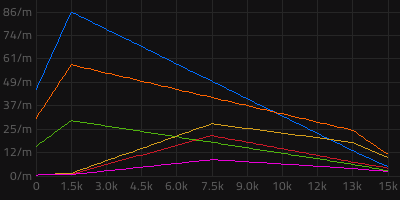 Space route from Nauvis to Gleba |
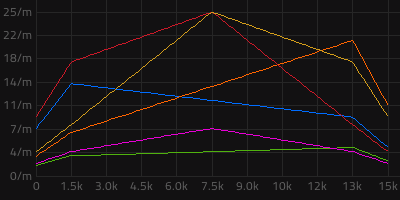 Space route from Vulcanus to Gleba |
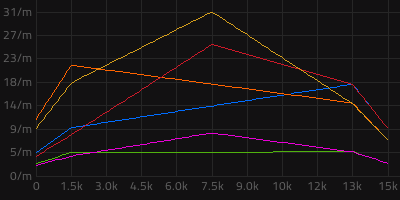 Space route from Gleba to Fulgora |
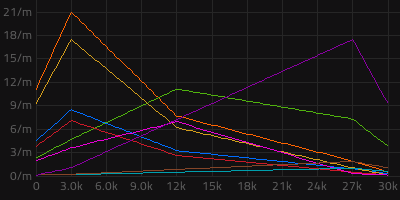 Space route from Gleba to Aquilo |
Graph legend:
| Asteroid type | Chunk | Medium | Big |
|---|---|---|---|
| ● Blue | ● Red | ● Cyan | |
| ● Orange | ● Yellow | ● Brown | |
| ● Green | ● Magenta | ● Purple |
Orbit
Properties
| Property | Value |
|---|---|
| Solar Power | 200% |
| Asteroid Type | Spawn Ratio |
|---|---|
| Metallic asteroid chunk | 2 |
| Carbonic asteroid chunk | 5 |
| Oxide asteroid chunk | 1 |
| Promethium asteroid chunk | 0 |
| Asteroid Size | Spawn % |
|---|---|
| Chunk | .30 |
| Medium | .25 |
| Big | 0 |
| Huge | 0 |
Note:
- Chunks spawn at Nauvis at 1.25%
- Huge Asteroids only spawn past Aquilo

Gallery
-
Example landscape of Gleba.
-
Example mapview of Gleba, different colors represent different biomes.
-
Gleba seen on the expansion's title screen.
Trivia
- In biology, a gleba is a fleshy, spore-filled inner mass of some fungus like the puffball.
- During development, Gleba was once named Bacchus, after the Roman god of fertility, orchards, and vegetation.
